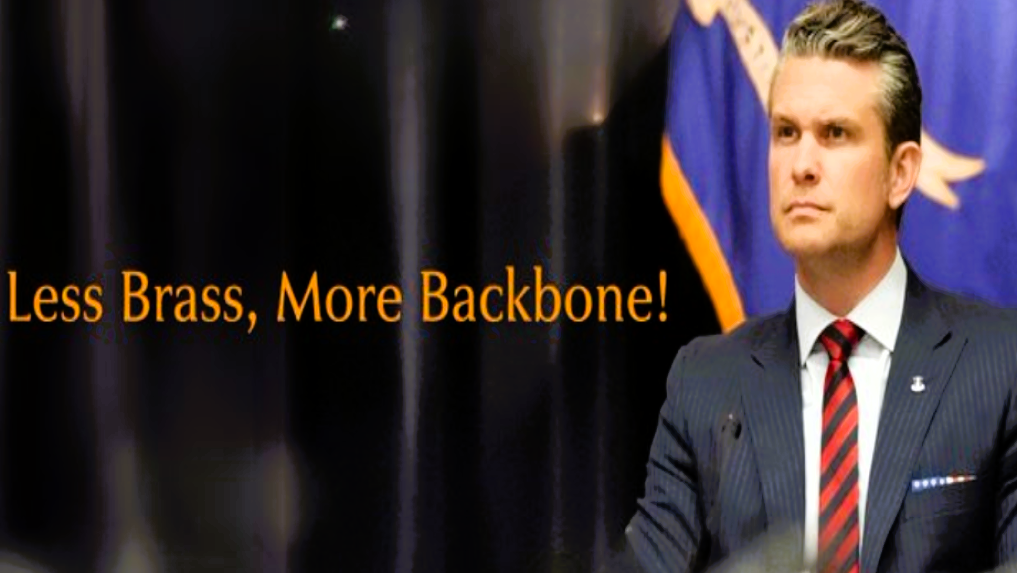FULL EXPOSURE: THE MILITARY IS BROKEN! PETE HEGSETH IS RIGHT: WE NEED MORE GIs, NOT MORE GENERALS – TRUMP, HEGSETH & THE COMBAT CODE
Ready to uncover the truth? Sick of the lies? Join our Telegram Channel now. It’s time for the real story! My gratitude to all my readers!
America doesn’t need more careerist generals playing politics. It needs warfighters — real patriots ready to defend, not comply.
TRUMP, HEGSETH & THE COMBAT CODE: MORE GIs. LESS SELLOUTS. NOW.
Amuse Report: In 1945, at the apogee of American military might, the United States fielded over 12 million active-duty service members. The war effort spanned continents and oceans, engaging enemies on two fronts with ferocious intensity. Amid this global conflagration, the military maintained a ratio of one general or admiral for every 6,000 troops. Fast-forward to 2025, and a sobering inversion appears: with just 1.35 million active-duty personnel, the Pentagon now houses one flag officer for every 1,400 troops. This is not progress. It is bureaucratic bloat masquerading as modernization.
Secretary of Defense Pete Hegseth, in a landmark reform announcement, has resolved to reverse this trend. With the full backing of President Trump, Hegseth has proposed a phased reduction of general and flag officers across all branches of the military, a minimum of 20% initially, with an additional 10% following a strategic review. These are not arbitrary cuts but carefully calculated adjustments to align military leadership with operational necessity. The slogan is simple: less brass, more GIs. The rationale is anything but simplistic.
To understand the urgency of this reform, one must begin with the numbers. During World War II, the military maintained roughly 2,000 flag officers. That number has since decreased, yet the proportion relative to the size of the force has more than tripled. Today, the military counts approximately 809 generals and admirals among its ranks. That figure may seem modest until one recognizes the disparity in scope. The modern force is nearly one-tenth the size it was in the 1940s, yet flag officers have not declined in proportion. Instead, their relative influence has metastasized, bloating headquarters staffs, diverting resources from field operations, and warping the chain of command.
Why does this matter? Because combat readiness and strategic deterrence are not abstract ideals. They are logistical realities grounded in efficient command structures and resource allocation. A military burdened with excess leadership is like a ship with too many captains and too few sailors. Headquarters multiply, commands proliferate, but tangible warfighting capability stagnates. And stagnation, in this century of asymmetric warfare and peer competition, is tantamount to decline.
Compounding this stagnation is a corrosive trend: many of the additional flag officers in recent decades have not been selected for their battlefield acumen or strategic insight, but rather to satisfy diversity quotas and demographic targets divorced from military merit. Promotion, once tethered to command effectiveness and operational success, has too often become a function of identity politics. Race, gender, and sexual orientation have been elevated as qualifying traits in themselves, rather than incidental attributes of competent leaders. The result is a distorted hierarchy, inflated not by excellence, but by optics.
This reduction, then, is not merely a fiscal or logistical imperative. It is a moral one. It allows the military to reassert a standard of leadership based on merit, not social engineering. By right-sizing the command structure, we create space to retain and promote the best minds and most capable leaders, those tested in war games and real wars alike, not in HR seminars or DEI briefings. This reform is an opportunity to restore excellence as the organizing principle of command.
Defenders of the current structure often invoke the complexities of modern warfare, cyber operations, joint commands, coalition diplomacy, and so forth. These are not trivial concerns. But complexity should not be an alibi for inefficiency. In fact, the very proliferation of commands to manage such complexity underscores the need for leaner leadership, not more layers. Strategic clarity arises not from multiplying intermediaries but from empowering decisive commanders with the tools and autonomy to act.
The Center for Strategic and International Studies, in a 2016 report, explored proposals to reduce general and flag officers by 25%. The findings were instructive: not only would such a reduction streamline operations, it would also complement existing efforts to cut redundant management layers. The Congressional Research Service later echoed these concerns, noting that the percentage of flag officers has climbed steadily over the last five decades. From 0.048% of the force in 1965 to 0.063% in 2023, the trendline is clear and concerning.
Don’t Miss This: Attention!!! What Happens When You Put The Most Powerful Energy Source In The World Near Your Beating Heart? You’re About To Find Out…
These are not merely dry statistics. They signal a shift in military culture from field competence to managerial oversight, from the fog of war to the fog of meetings. The modern flag officer often finds himself ensnared in administrative sprawl, his authority diluted across layers of coordination committees, PowerPoint briefings, and interagency liaisons. What was once a vocation of command risks becoming a career of consultation.
President Trump, with his characteristic clarity, has long understood the dangers of bureaucracy unchecked by necessity. His elevation of Hegseth and the creation of the Department of Government Efficiency under Elon Musk are not accidents of populist caprice but deliberate correctives to a government grown sclerotic. The military, like every federal institution, must serve its ends, not perpetuate its own inertia.
Moreover, this reform is not a rebuke of generals per se.
It is a recognition that the strength of a military lies not in the epaulets adorning its highest officers but in the steel resolve of its infantry, the precision of its pilots, the vigilance of its sailors. Reallocating resources from headquarters to the front lines affirms this principle. It means more training, better equipment, enhanced support, and greater morale for those who bear the burdens of combat.

Critics will claim such reductions risk readiness, that fewer generals mean less strategic capacity. But the opposite is true. Over-centralization diffuses accountability and fosters indecision. By restoring a more historically grounded ratio of officers to troops, we strengthen the military’s responsiveness. This is not conjecture but precedent. The Goldwater-Nichols reforms of 1986, which recalibrated command structures and clarified operational responsibilities, produced a leaner, more agile force. Hegseth’s initiative echoes that legacy.
Phase one of the reform targets immediate reductions within the active-duty components and the National Guard Bureau, setting a floor of 20% reduction. Phase two aims higher: a comprehensive reevaluation of the Unified Command Plan, designed to achieve an additional 10% reduction in general and flag officers across the Department of Defense. The review is expected to be the most exhaustive since Goldwater-Nichols. It could not come at a more vital moment.
America today faces a fluid and fractious threat environment. China flexes its muscles in the Indo-Pacific, Russia grinds forward in Eastern Europe, and Iran orchestrates terror through regional proxies. Deterrence demands clarity, cohesion, and conviction. It does not demand bloated command chains or redundant hierarchies. The path to peace through strength lies in sharpened readiness, not in ceremonial rank.
There is also a fiscal dimension. Flag officers, with their staffs, perks, and extensive support networks, represent a significant financial burden. Trimming their ranks is not merely symbolic; it yields real savings that can be redirected to modernization and recruitment. A leaner leadership cadre means a more sustainable defense budget.
Nor is this effort isolated. It complements broader administrative overhauls underway under President Trump’s second term. From reorganizing the EPA under Lee Zeldin to streamlining State under Marco Rubio, the Trump administration is engaged in a full-spectrum reassessment of government efficiency. The Pentagon is not exempt. Indeed, it is a necessary front.
MAHA! MAKE AMERICA HEALTHY AGAIN: HOME RETREAT | HOW TO RENEW YOUR CELLS IN 7 DAYS
To question entrenched hierarchies is to court resistance. But conservatism, properly understood, is not about conserving inefficiency. It is about conserving purpose. And the purpose of the American military is not to provide sinecures for senior officers but to defend the nation. Every dollar, every billet, every decision must serve that end.
Less brass, more backbone. That is the creed behind Pete Hegseth’s initiative. And it is the creed that must animate any serious effort to restore the primacy of purpose in the United States military. The days of sprawling headquarters issuing edicts to dwindling ranks must end. Let us once again place our trust not in the volume of stars on a shoulder, but in the strength, skill, and spirit of the American warfighter.
SOURCE: https://x.com/amuse/status/1919733191184715881










![BREAKING ALERT: THE PENTAGON GOES CODE BLACK | CHINA PREPARES FOR WAR | PETE HEGSETH WARNING: “THE THREAT IS REAL. IMMINENT. TOTAL.” [VIDEO]](https://amg-news.com/wp-content/uploads/2025/05/U.S.-Defense-Secretary-Pete-Hegseth-issues-a-chilling-warning-the-threat-from-China-is-real-and-imminent-450x272.png)


2 Comments
GIVE ME A CALL JUST GIVE ME CALL ALA DAM BAMA
If Trump want’s more GI’s, then pay them. They will sign up for good pay.